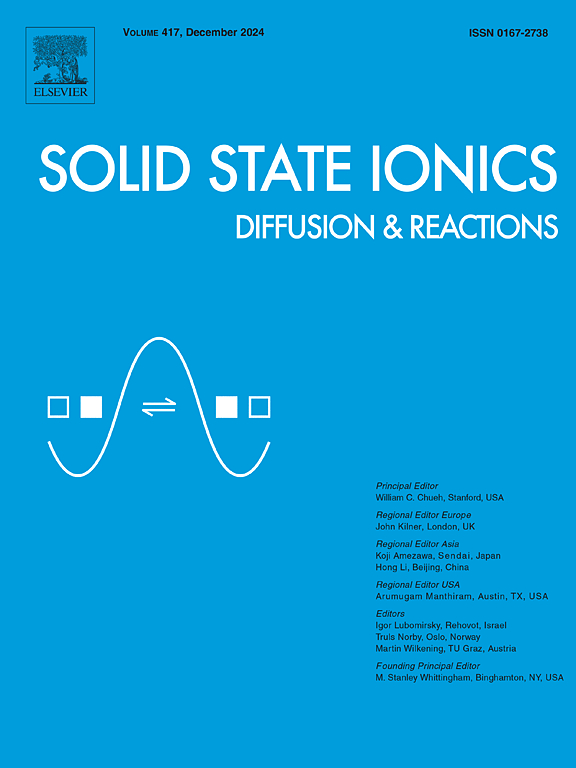致密多孔La0.6Sr0.4CoO3-δ电极上的高温氧交换反应:模拟实验证据综述
IF 3.3
4区 材料科学
Q3 CHEMISTRY, PHYSICAL
引用次数: 0
摘要
为了模拟SOFC和SOEC中混合导电氧化物电极的电流-电位关系,研究了氧交换动力学。以La0.6Sr0.4CoO3为模型材料,对本课题组目前获得的实验证据进行总结和重新分析。反应顺序分析表明反应机理复杂,可分为表面过程和次表面过程两个系列动力学。前者是指气相氧分子与某种表面氧之间的交换过程。后者是指表面氧与大块氧化离子的交换,反应屏障不一定是氧输运,而可能是电子输运/氧在/氧在/氧在/氧在/氧在/氧在/氧在/氧在/氧在/氧在/氧在/氧在/氧在/氧在/氧在/氧在/氧在/氧在/氧在/氧在/氧在/氧在/氧在/氧在/氧在/氧在/氧在/氧在/氧在/氧在/氧之间的转移。这一假设似乎解决了我们对实验结果的一些遗留问题,如在高分压范围内分散的pO2依赖性,同位素交换速率高于电化学阻抗,在LaSrCoO4相存在下,反应速率提高。虽然单个这样的实验证据不足以证明这一假设,但综合考虑所有的结果,就提供了强有力的支持。然后,我们尝试通过使用多孔氧传感器测量表面氧势来分离表面和地下过程的贡献。结果表明,表面过程为Js=Js,0∙δ∙aO,s2−pO2,g,地下过程为Jss=Jss,0∙aO,eaO,s−1−aO,e−1aO,s=Jss,0expβ∆μO2RT - exp−1−β∆μO2RT,即使在不同氧空位形成能的薄膜上也与实验数据吻合较好。对于多孔电极的建模,基于实验证据,我们认为没有必要考虑亚表面过程,例如多孔电极中颗粒表面的面积比反应速率高于膜电极,以及LaSrCoO4相缺乏增强作用。将j应用于传输线模型所估计的电流-电压关系与实验结果吻合较好。本文章由计算机程序翻译,如有差异,请以英文原文为准。
High temperature oxygen exchange reaction on dense and porous La0.6Sr0.4CoO3-δ electrodes: An overview of the experimental evidence for modeling
Oxygen exchange kinetics was investigated to model the current-potential relationship of mixed conducting oxide electrodes used in SOFC and SOEC. Focusing on La0.6Sr0.4CoO3 as a model material, experimental evidence so far obtained in our group were summarized and reanalyzed. The reaction order analysis suggested a complex reaction mechanism, for which we came to think of two series kinetics, surface process and subsurface process. The former refers to an exchange process between gas-phase oxygen molecules and some sort of surface oxygen species. The latter refers to the exchange of surface oxygen with bulk oxide ions, and the reaction barrier is not necessarily oxygen transport, but may be electron transport/transfer for oxygen in/ex-corporation This hypothesis appeared to resolve some of our remaining questions regarding the experimental results, such as scattered pO2 dependence in high partial pressure range, the higher isotope exchange rates than electrochemical impedance, and the reaction rate enhancement in the presence of the LaSrCoO4 phase. While a single piece of such experimental evidence is insufficient to prove the hypothesis, considering all the results together provides strong support. We then tried to separate the contributions of surface and subsurface processes by measuring the surface oxygen potential using a porous oxygen sensor. It revealed that the surface process is written as and the subsurface process as , which are in good agreement with the experimental data even for films with different oxygen vacancy formation energies. For modeling porous electrodes, we considered it unnecessary to include the subsurface process based on experimental evidences, such as the higher area-specific reaction rate on the particle surface in a porous electrode than on the film electrode, and the lack of enhancement effect by LaSrCoO4 phase. The current-voltage relationship estimated by applying Js to the transmission line model was in good agreement with the experimental results.
求助全文
通过发布文献求助,成功后即可免费获取论文全文。
去求助
来源期刊

Solid State Ionics
物理-物理:凝聚态物理
CiteScore
6.10
自引率
3.10%
发文量
152
审稿时长
58 days
期刊介绍:
This interdisciplinary journal is devoted to the physics, chemistry and materials science of diffusion, mass transport, and reactivity of solids. The major part of each issue is devoted to articles on:
(i) physics and chemistry of defects in solids;
(ii) reactions in and on solids, e.g. intercalation, corrosion, oxidation, sintering;
(iii) ion transport measurements, mechanisms and theory;
(iv) solid state electrochemistry;
(v) ionically-electronically mixed conducting solids.
Related technological applications are also included, provided their characteristics are interpreted in terms of the basic solid state properties.
Review papers and relevant symposium proceedings are welcome.
 求助内容:
求助内容: 应助结果提醒方式:
应助结果提醒方式:


